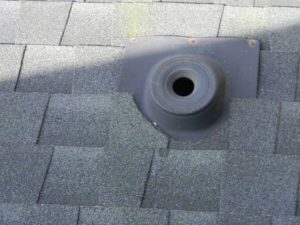Background
It was reported that a church building was damaged during the passage of Hurricane Isaac on August 29, 2012. The specific damage reported was that wind pressures damaged the roof coverings of the building and that rainwater entered the interior of the building during the storm and damaged the interior finishes. U.S. Forensic was retained to perform an evaluation of the building and to determine the cause and extent of the reported damage.
Evaluation & Findings: Exterior
Our work to complete this assignment was performed by William Janowsky, P.E. Mr. Janowsky reviewed weather information that indicated elevated wind pressures affected the area during the passage of Hurricane Isaac on August 29, 2012. During the site visit, he observed 7 missing or damaged shingles on the main roof ridge, approximately 4 square feet of missing or damaged shingles at the lower east corner of the south roof slope, approximately 32 ridge shingles missing from the lower northeast portion of the roof, approximately 18 square feet of missing or damaged shingles along the lower north edge of the east roof slope, and approximately 15 feet of displaced gutter at the northeast corner of the building. The noted conditions were consistent with damage caused by wind pressures and were attributed to the storm event of August 29, 2012.
Wind forces typically cause damage to features located at the higher elevations of buildings such as roof coverings and have progressively less effect upon the lower portions of structures such as walls, floors and foundations. The maximum wind gust speeds in the area during the passage of Hurricane Isaac were reported to be approximately 90 mph. The limited damage to the roof coverings of the building was consistent with the noted wind speeds but no broken windows or damaged building framing was observed and winds of this magnitude would not be expected to cause damage to the structure, walls, or foundation of a properly constructed and maintained building. No evidence of any shifting, movement, deflection, or damage to the framing members or foundation components was observed at the property. The physical evidence observed at the site indicated that the subject building was not structurally damaged by wind pressures that affected the property during the passage of Hurricane Isaac.
Evaluation & Findings: Interior
Within the interior of the building, Mr. Janowsky observed stains and displaced joint tape on the ceiling in one of the rooms in the church building. Damage was observed to the roof above the noted room where there was an uncovered opening from a displaced PVC vent line. The damage was consistent with exposure to moisture and was attributed to rainwater that entered the interior of the building through the damaged roof coverings and the displaced vent line flashing during and after the passage of Hurricane Isaac.
Within the central portion of the building, an isolated area of sagging paint was present on the wall directly beneath the duct race for the air conditioning system. There was no damage to the roof coverings above the noted area and no evidence of moisture intrusion was observed in the attic area above the damaged paint. Condensation often forms on air conditioning ducts at contact points with framing or insulation and the sagging paint occurred on a wall directly below a duct and a wall intersection. The conditions observed at the site indicated that the sagging paint on the wall was caused by condensation repeatedly formed on the duct and dripped down on the wall surface and was unrelated to the passage of Hurricane Isaac.
Within the west end of the building, stains and distorted paint and joint tape were noted on the upper and lower portions of the wall and ceiling adjacent to the large stained glass window. These stains extended to the ceiling surface and within the attic area. Mr. Janowsky observed dark, concentric stains on the wood framing within the belfry locate directly above the window. The stains in the belfry occurred directly below the louvered openings at the top of the bell tower and indicated that rainwater routinely entered the interior of the building through the louvers.
Photographs
- View of missing ridge shingles on the lower roof area at the east end of the building
- View of a loose shingle deposited on the south roof slope at the west end of the building
- View of an area of missing and damaged shingles at the lower east end of the south roof slope
- View of an open vent line boot flashing on the lower roof above the northeast corner of the building
- View of sagging paint on the wall beneath the air conditioner system duct within the southeast portion of the building
- View of stains on the ceiling and distorted paint on the lower portion of the west wall of the building
- View of a dark stain on the ceiling within the northeast portion of the building
- View of an opening in the roof decking directly below the open vent boot flashing at the northeast portion of the building
- View of a disconnected PVC vent line above the stains on the ceiling in the northeast portion of the building
- View of dark stains on the wood framing within the belfry at the west end of the building. Note the louvered opening directly above the stains














